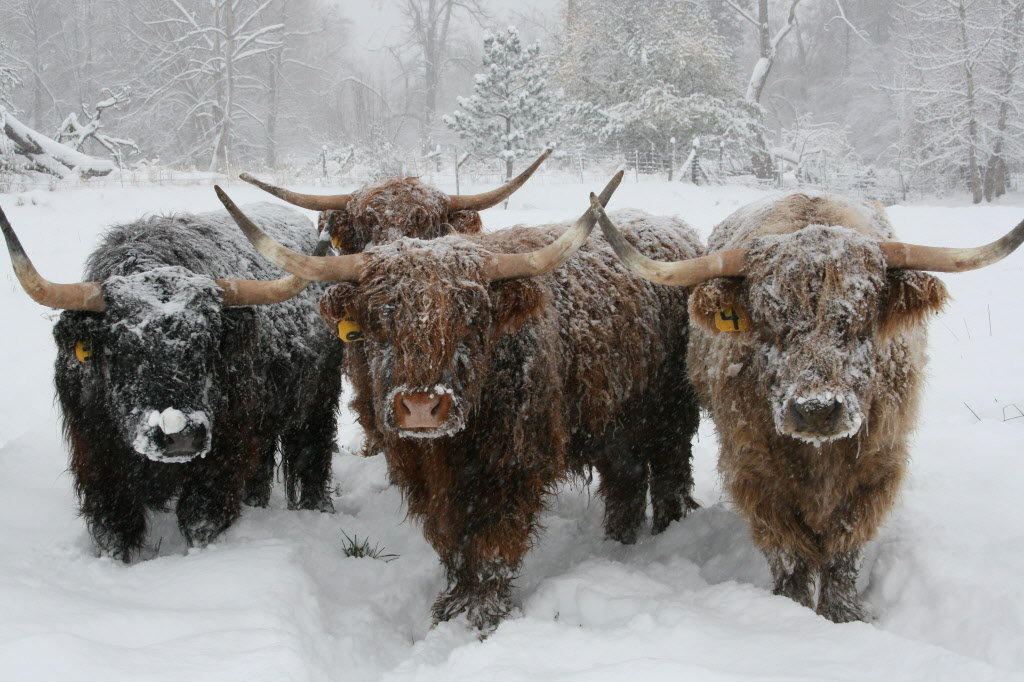Efficiencies in the Barn
I was born and grew up in New Zealand, where animals eat grass / hay, and live outside year round as a matter of course.Moving to Canada, it struck me as an incredible amount of work, albeit necessary work, having to move livestock indoors for the better part of 6 months and tend to their every whim.
I was also left with the lingering question over who exactly worked for who on the Canadian farm...
Surely, if we look at the whole animal housing landscape through permaculture lenses, we will discover innovative ways to care for livestock during the winter months. Ways that are energy conservative, lighten the burden on the farmer, and do so with respect to the welfare of the animals.
It turns out that livestock may not need to be housed quite as long as traditionally thought. Cows are capable of finding forage under snow, which means not only less heating costs, but also less feed storage, and the work required to make hay, muck out, etc.
Researchers at the University of Guelph conducted some research on this and came back with some interesting findings. Even though the cattle lost weight over the winter, this is not necessarily a bad thing.
The advantages of putting the cows outside during the day include access to clean air, sunlight, and exercise. These factors influence the efficiency of immune systems, lymphatic systems, and general cardiovascular performance.
Selecting breeds more suited to this kind of lifestyle may reduce the direct output of the herd (in terms of milk etc), however when the overall energy audit of the system is conducted, the reduced output is more than compensated for by the reduced energy inputs.
Another approach to increasing efficiency in the barn is to have the livestock perform work that the farmer would otherwise do with machinery or simple hard labor.
An example of this is what is termed pig aeration. In a typical barn, cow manure builds up during the winter and the compacted mass off manure and bedding must be removed in the spring time.
Pig aeration involves adding more carbon to the bedding than is traditional so that the correct Carbon:Nitrogen ratio (30:1) is achieved for making compost. Corn is intermittently dispersed over the bedding as it build up and it sits there slowly fermenting until spring.
When the cows are moved out, pigs are moved in, and they dig up the compacted bedding in search of the fermented corn which they seem to think is candy. As they turn the bedding, they introduce air, and the composting process accelerates.
By the time the pigs are done, they have put on a significant about of weight, the bedding is nicely composted, easy to extract, and ready to be used for fertiliser.
An Ontario farmer is reportedly using long stem barley for the same purpose. I doubt there is such a thing as a long stem barley, so I suspect that it is in fact a heritage wheat. Anyway, he simply cuts the cereal, bales it, stores it with the heads on, and uses it as required for the bedding. The pigs then go in after the grain and aerate the bedding.
It takes 10 weaners a month to aerate 200 sq feet of bedding that is 3ft thick, and during this time they get no other feed.
A final thought I will leave you with is the possibility of using chickens to turn bedding or compost. Chickens love to scratch, and when they work bedding over, they push it all downhill, rather than in a random fashion as one would assume. They do this even when the floor is only a little off level, which means that they might be a useful cleaning crew in the barn.




No comments:
Post a Comment